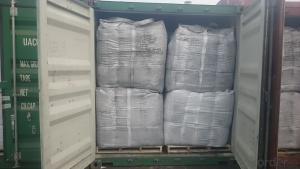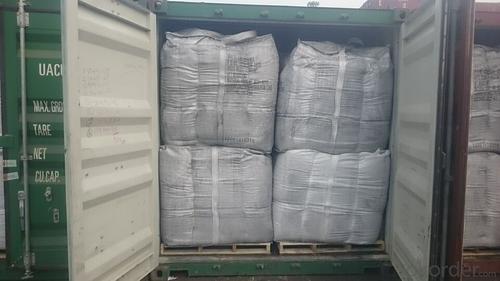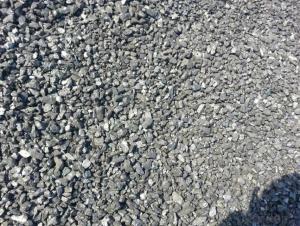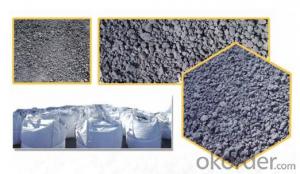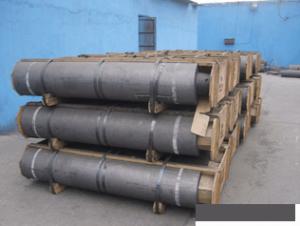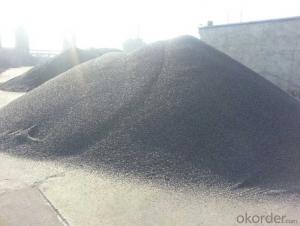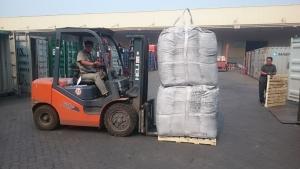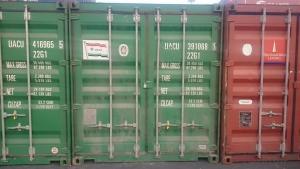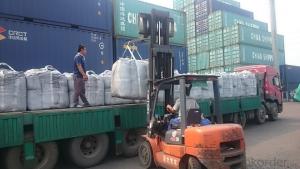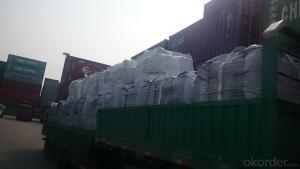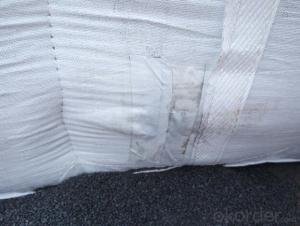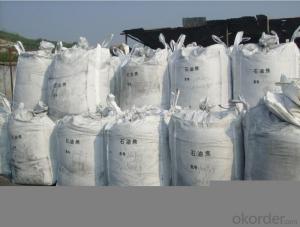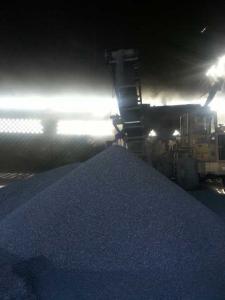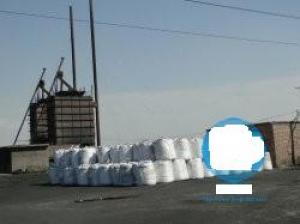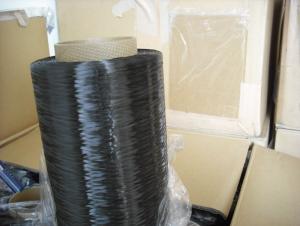Used in EAF as Charge Coke for Foundry plants with Moisture 0.5%max
- Loading Port:
- Tianjin
- Payment Terms:
- TT OR LC
- Min Order Qty:
- 21 m.t.
- Supply Capability:
- 6000 m.t./month
OKorder Service Pledge
OKorder Financial Service
You Might Also Like
Introduction:
Calcined anthracite can be called carbon additive, carbon raiser, recarburizer, injection coke, charging coke, gas calcined anthracite.
Carbon Additive/Calcined Anthracite Coal may substitute massively refinery coke or graphite. Meanwhile its cost is much less than the refinery coke and graphite. Carbon Additive is mainly used in electric steel ovens, water filtering, rust removal in shipbuilding and production of carbon material.
It has good characteristics with low ash, low resistivity, low sulphur, high carbon and high density. It is the best material for high quality carbon products. It is used as carbon additive in steel industry or fuel.
Features:
Best quality Taixi anthracite as raw materials through high temperature calcined at 800-1200 ℃ by the DC electric calciner with results in eliminating the moisture and volatile matter from Anthracite efficiently, improving the density and the electric conductivity and strengthening the mechanical strength and anti-oxidation, It has good characteristics with low ash, low resistivity, low carbon and high density. It is the best material for high quality carbon products, it is used as carbon additive in steel industry or fuel.
Specifications:
F.C.% | 95MIN | 94MIN | 93MIN | 92MIN | 90MIN | 85MIN | 84MIN |
ASH % | 4MAX | 5MAX | 6 MAX | 6.5MAX | 8.5MAX | 12MAX | 13MAX |
V.M.% | 1 MAX | 1MAX | 1.0MAX | 1.5MAX | 1.5MAX | 3 MAX | 3 MAX |
SULFUR % | 0.3MAX | 0.3MAX | 0.3MAX | 0.35MAX | 0.35MAX | 0.5MAX | 0.5MAX |
MOISTURE % | 0.5MAX | 0.5MAX | 0.5MAX | 0.5MAX | 0.5MAX | 1MAX | 1MAX |
Pictures

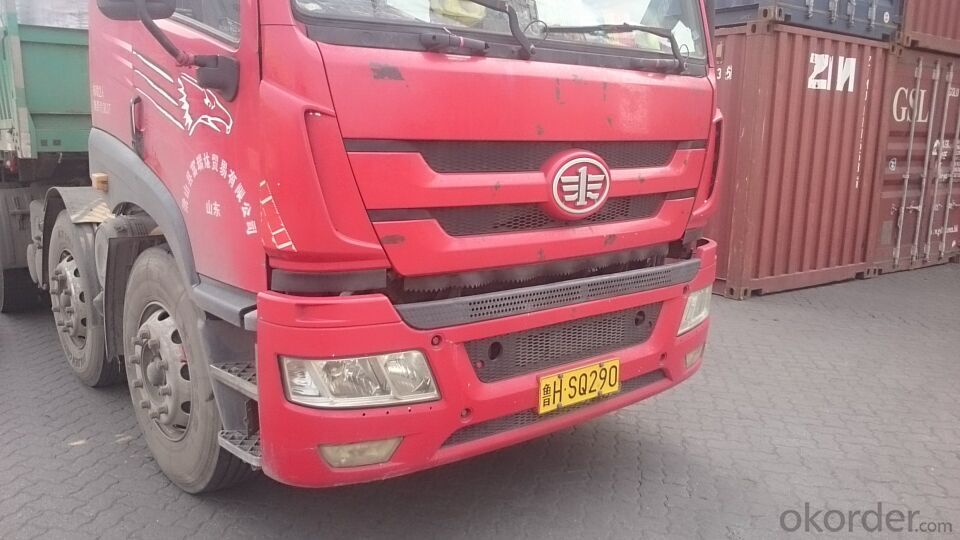
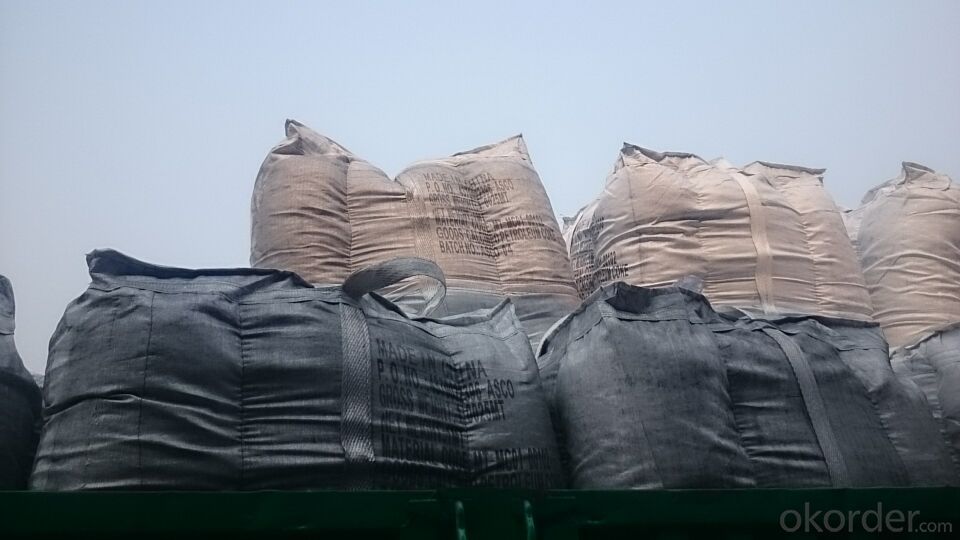
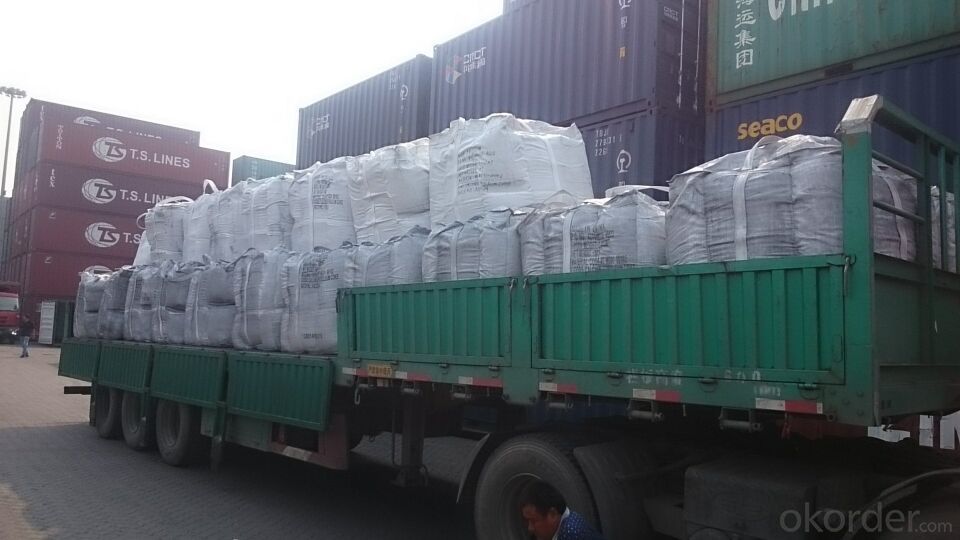
FAQ:
Packing:
(1). Waterproof jumbo bags: 800kgs~1100kgs/ bag according to different grain sizes;
(2). Waterproof PP woven bags / Paper bags: 5kg / 7.5kg / 12.5kg / 20kg / 25kg / 30kg / 50kg small bags;
(3). Small bags into jumbo bags: waterproof PP woven bags / paper bags in 800kg ~1100kg jumbo bags.
Payment terms
20% down payment and 80% against copy of B/L.
Workable LC at sight,
- Q: When will amines be fertilized?
- Avoid high temperature applications. The temperature is below 20 DEG C when ammonium bicarbonate is relatively stable, high temperature or moisture in the product exceeds a certain standard, is easy to be decomposed into ammonia and carbon dioxide emissions in the air, causing loss of nitrogen fertilizer. According to the test results show that the winter crops better than urea and ammonium carbonate. Because the temperature is low in winter, the process of urea conversion is long, but the ammonium carbonate can be directly absorbed without conversion. It is beneficial to the early growth and fast growth of winter crops. In addition, when applied to the soil ammonium bicarbonate, ammonium ion dissociation can be directly by soil colloid adsorption, and urea to winter crop soil, urea was dissolved in the soil solution in the molecular state, but not by soil colloid adsorption, it is more likely to cause the loss of nutrientsThe use of ammonium bicarbonate does not mix with alkaline fertilizers, which can lead to loss of nitrogen nutrients, resulting in low fertilizer efficiency. Using ammonium hydrogen carbonate friends should know that not with urea and ammonium hydrogen carbonate mixed fertilizer, ammonium bicarbonate if mixed with urea, urea conversion rate will not only extend, and will accelerate the volatilization of urea.Ammonium bicarbonate extremely volatile, so to avoid the ground using ammonium bicarbonate, ammonium bicarbonate has strong corrosion on leaf blade, easy to burn, can not be used as a foliar spray. There is one thing to note is that if the soil drought, even deep application coverage, can not be dissolved in ammonium bicarbonate, better soil moisture using ammonium bicarbonate, can reduce the volatilization loss, improve efficiency
- Q: How is carbon used in the production of diamonds?
- The production of diamonds relies heavily on carbon, which is the primary component that constructs the diamond's structure. Deep within the Earth's mantle, where there are extreme levels of heat and pressure, carbon atoms bond together in a distinctive crystal lattice formation, giving birth to diamonds. This natural process, called carbon crystallization, takes place over an extensive period of millions of years. To create synthetic diamonds, scientists recreate these intense conditions in a laboratory. They employ high-pressure, high-temperature (HPHT) machines to subject a tiny piece of carbon, like graphite, to immense pressure and heat. This simulation imitates the natural process that occurs in the Earth's mantle, allowing the carbon atoms to rearrange themselves and transform into diamonds. An alternative method, known as chemical vapor deposition (CVD), involves the controlled use of a hydrocarbon gas, such as methane, in a specific environment. The gas is introduced into a chamber and heated, causing the carbon atoms to separate from the hydrogen atoms. These carbon atoms then settle on a substrate, like a diamond seed, and gradually accumulate layer by layer, eventually forming a diamond. In both methods, carbon acts as the fundamental building block for the diamond's structure. By manipulating the conditions in which carbon atoms are exposed to extreme heat and pressure, scientists and manufacturers are able to control the growth and formation of diamonds. This manipulation allows for the production of synthetic diamonds that possess identical physical and chemical properties to natural diamonds. In conclusion, carbon plays an indispensable role in the production of diamonds, serving as the essential element that facilitates the formation and growth of these valuable gemstones.
- Q: What is the relationship between carbon and climate change?
- The carbon-climate relationship mainly relies on the role of carbon dioxide (CO2) as a greenhouse gas. CO2 naturally exists in the Earth's atmosphere and is indispensable for maintaining a livable climate by ensnaring heat from the sun and preventing its escape into space. Nevertheless, human activities, particularly the combustion of fossil fuels like coal, oil, and natural gas, have substantially raised the levels of CO2 in the atmosphere. The surplus CO2 functions as an added layer, capturing more heat and resulting in a phenomenon called the greenhouse effect. This surge in greenhouse gases, including CO2, methane, and nitrous oxide, is causing global temperatures to climb and consequently leading to climate change. The elevated temperatures disturb weather patterns, leading to more frequent and intense extreme weather events such as hurricanes, droughts, heatwaves, and heavy rainfall. Moreover, the excessive CO2 in the atmosphere is also being absorbed by the oceans worldwide, resulting in ocean acidification. This process modifies the chemical composition of seawater, which has adverse effects on marine life, coral reefs, and other ecosystems. It is crucial to reduce carbon emissions and transition to renewable energy sources to mitigate climate change. By diminishing the amount of CO2 released into the atmosphere, we can decelerate and potentially reverse the detrimental impacts of climate change. Additionally, efforts to preserve and restore forests, which act as carbon sinks by absorbing CO2, are also essential in addressing the carbon-climate relationship.
- Q: How does carbon affect the formation of cyclones?
- Carbon does not directly affect the formation of cyclones. Cyclones, also known as hurricanes or typhoons, are formed through a complex interaction of various atmospheric and oceanic factors. Carbon, specifically carbon dioxide (CO2), is a greenhouse gas that contributes to global warming and climate change. It is important to note that while carbon dioxide concentrations in the atmosphere are increasing due to human activities, such as burning fossil fuels, it does not directly cause the formation of cyclones. However, climate change resulting from increased carbon dioxide levels does have an indirect influence on cyclone formation. Warmer temperatures due to climate change can lead to increased sea surface temperatures, which provide the energy necessary for cyclone formation and intensification. Higher temperatures also increase evaporation rates, leading to more moisture in the atmosphere that can fuel cyclone development. Furthermore, climate change can alter atmospheric conditions and circulation patterns, which may affect the frequency, intensity, and tracks of cyclones. However, the specific impact of carbon dioxide on cyclone formation and behavior is still an active area of research, and more studies are needed to fully understand the relationship between carbon dioxide and cyclones.
- Q: What is the difference between soil organic matter and soil organic carbon?
- Usually we measured is organic carbon, and then multiplied by 1.724 is organic matter.
- Q: How do you stick carbon fabric?
- 1 、 construction tools and equipmentThe main equipment includes cutting machine, angle grinder and roller brush2, concrete substrate treatment(1) remove the damaged parts and damaged parts of the concrete parts and reach the compacted parts(2) check whether exposed steel bars are rusted or not. If there is rust, the necessary treatment should be carried out(3) repair the damaged part of the component through the chisel, the cleaning and the exposed ribs, and then use the epoxy mortar, which is higher than the strength of the original component concrete, to repair and restore to the surface(4) crack repair. Cracks with a width of less than 0.20mm shall be coated with epoxy resin and sealed. Cracks greater than or equal to 0.20mm shall be sewed with epoxy resin(5) to the designated location, scope of patch repair and reinforcement of ink, according to the design requirements.(6) burnish the surface of the member (the connecting part of the concrete component, the difference of the section of the template), and make sure that the repaired section is as smooth as possible(7) the angular position, with grinder. Rounding radius should be larger than 30mm, the minimum of not less than 20mm.
- Q: How does carbon affect the formation of toxic algal blooms?
- Carbon can affect the formation of toxic algal blooms by providing an essential nutrient source for the growth and proliferation of algae. Increased carbon levels in water bodies, often caused by human activities such as excessive fertilizer use and wastewater discharge, can lead to an imbalance in the aquatic ecosystem. This imbalance promotes the rapid growth of algae, including toxic species, which can release harmful toxins into the water, posing risks to human and animal health as well as the overall ecological health of the water body.
- Q: How does carbon dioxide affect the formation of smog?
- Smog formation is not directly caused by carbon dioxide (CO2). Instead, it is primarily a result of sunlight interacting with other pollutants like nitrogen oxides (NOx) and volatile organic compounds (VOCs). These pollutants are emitted from various sources such as vehicles, industrial processes, and power plants. However, even though carbon dioxide doesn't directly participate in smog formation, it does have a significant impact on climate change. CO2 is a greenhouse gas, which means it traps heat in the Earth's atmosphere and contributes to global warming. As the planet warms, weather patterns can change, leading to more stagnant air conditions that worsen smog formation. Furthermore, the burning of fossil fuels, which releases carbon dioxide, is a major source of air pollutants like NOx and VOCs. So while CO2 itself may not directly cause smog, the activities that release CO2 indirectly contribute to smog formation by releasing other pollutants involved in its creation. Therefore, the influence of carbon dioxide on smog formation is indirect, primarily through its contribution to climate change and the release of other pollutants. By reducing carbon dioxide emissions and transitioning to cleaner energy sources, we can help mitigate climate change and indirectly decrease the factors contributing to smog formation.
- Q: How to test aldehyde group and carbon carbon double bond in acrolein
- Can be oxidized into carboxyl aldehyde with silver ammonia solution or new copper hydroxide, then the bromine test double bonds, because the aldehyde will affect the bond detection, and will not affect the detection of double bond of carboxyl.
- Q: What are the applications of graphite in industry?
- Graphite possesses distinct properties that make it suitable for a range of applications across industries. Here are several key uses of graphite in different industrial sectors: 1. Lubricants: Given its low friction coefficient, graphite is extensively employed as a solid lubricant in industries that encounter high temperatures and extreme pressures, like automotive, aerospace, and heavy machinery. 2. Refractories: Graphite's exceptional heat and chemical resistance make it an ideal material for manufacturing refractory products. It helps line furnaces, crucibles, and other high-temperature equipment in metal production, glass manufacturing, and chemical processing. 3. Electrical industry: Graphite's excellent electrical conductivity makes it widely utilized in this sector. It is employed to produce electrodes, brushes, and contacts for electrical motors, generators, and batteries. Furthermore, graphite serves as a component in electrical discharge machining (EDM) and conductive paints and coatings. 4. Foundry industry: Graphite acts as a mold and core material in the foundry industry, owing to its high thermal conductivity and ability to withstand high temperatures. It finds application in various metal casting processes, including sand casting, investment casting, and continuous casting. 5. Chemical industry: The chemical industry benefits from graphite's corrosion resistance and capacity to endure high temperatures. It is utilized in the manufacture of chemical equipment such as heat exchangers, reactors, and pipes, where it can withstand aggressive chemical environments. 6. Nuclear industry: In the nuclear industry, graphite serves as a moderator in nuclear reactors. Its ability to slow down neutrons allows for controlled nuclear fission reactions. Additionally, graphite is employed as a structural material in certain types of nuclear reactors. 7. Composite materials: Graphite is frequently used as a reinforcement material in the production of composite materials. By combining graphite fibers or sheets with resins or metals, lightweight and high-strength composites are created for applications in aerospace, automotive, and sporting goods industries. In conclusion, graphite's unique properties, encompassing high thermal and electrical conductivity, lubricity, and chemical inertness, contribute to its versatility as a material with diverse applications across industries.
Send your message to us
Used in EAF as Charge Coke for Foundry plants with Moisture 0.5%max
- Loading Port:
- Tianjin
- Payment Terms:
- TT OR LC
- Min Order Qty:
- 21 m.t.
- Supply Capability:
- 6000 m.t./month
OKorder Service Pledge
OKorder Financial Service
Similar products
Hot products
Hot Searches
